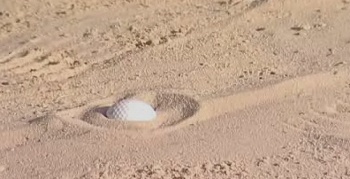
Understanding the Golf Term “Plugged Lie”
When it comes to playing golf, understanding the various terms and concepts is essential. One important term to grasp is the “plugged lie”.
A plugged lie, also known as a “fried egg lie”, refers to a ball that becomes deeply embedded or buried into the ground upon impact. This typically occurs when a golfer's ball lands in a soft, wet, or sandy area of the course, causing it to sink into the ground instead of bouncing or rolling normally.
Here are a few key points to understand about a plugged lie:
- 1. Causes: Plugged lies are commonly caused by shots that land in areas with wet or compacted sand, thick rough, or soft fairways. When the ball hits these types of surfaces at a high angle, it can bury itself into the ground instead of bouncing or rolling.
- 2. Effects: When your ball has a plugged lie, it becomes difficult to make clean contact and control your shot. The surrounding turf generally obstructs your clubhead, making it harder to strike the ball effectively. Plugged lies typically result in reduced distance and accuracy, adding an extra challenge to your game.
- 3. Strategies: To tackle a plugged lie, consider the following strategies:
- a. Safety Shot: If the plugged lie is in a precarious location, such as near a water hazard or with challenging obstacles in the way, it may be wise to play a safety shot. This involves taking an unplayable lie penalty by dropping the ball away from the plugged lie area.
- b. Bunker Play: If your plugged lie occurs in a bunker, you can utilize the appropriate technique for bunker play. Open the clubface and aim to hit the sand directly behind the ball to pop it out of the plugged position.
- c. Ball Positioning: When tackling a plugged lie, consider adjusting your ball position in your stance. Setting the ball slightly back in your stance can help you strike the ball with a steeper angle of attack, aiding in lifting it out of the plugged lie.
- d. Club Selection: Depending on the severity of the plugged lie and the distance you need to cover, you may want to select a club with higher loft to help you get the ball into the air more easily.
Ultimately, facing a plugged lie on the golf course requires skill, strategy, and adaptation. Understanding how to approach this situation will help you make more informed decisions and improve your chances of success.
Remember, practice and experience are key when it comes to handling plugged lies. The more you expose yourself to different golf course conditions, the better equipped you'll be to handle challenging lies like this.





